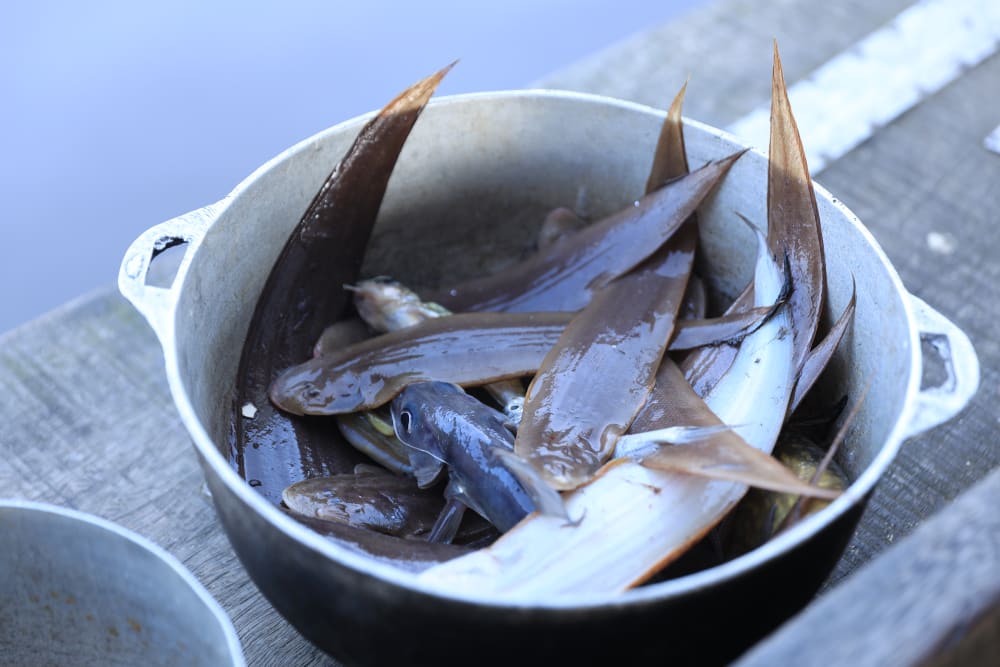
Antoinette Oni's G.A.S. Art for the Environment Residency Report

- Written byAntoinette Oni
- Published date 15 May 2024

Antoinette Oni (MArch Architecture, Central Saint Martins, 2022) was selected for the AER Residency at Guest Artists Space, Ijebu, Nigeria. Here, they report back to the Post-Grad Community on their experience.
Set up by Professor Lucy Orta (UAL Chair of Art for the Environment - Centre for Sustainable Fashion) in 2015, The Art for the Environment International Artist Residency Programme (AER) provides UAL graduates with the exceptional opportunity to apply for short residencies at one of our internationally renowned host institutions, to explore concerns that define the 21st century - biodiversity, environmental sustainability, social economy, and human rights.

I’ve always thought my architectural education embedded resilience and perseverance into my practice; however, nothing could have prepared me for the tests of patience awaiting me at the Guest Artist Space. I learned to lean into the creative process as a way of navigating this difficult terrain. I had to stubbornly commit my efforts to the execution of the film project, even when confronted with difficult challenges in its early stages. However, this experience taught me that a refined outcome is a result of iterative work, diligent preparation, and an unhinged optimism to overcome the obstacles and climb the steep learning curves that life throws at creative practitioners.

A four-week stay at the fifty-four-acre Ecological Farm birthed a new appreciation for the natural world. Living in a more balanced ecosystem was a revelation of just how well designed the planet is in its original form. Before travelling, I was concerned about being terrorised by mosquitoes and sand flies, topped off with the agonising heat of the late rainy season—itchy childhood memories from a sweltering school dormitory. But alas, the farm didn’t have the stagnant water of city sewage systems or the blocked canals of the metropolis. Frogs, forest geckos, and a robust cavalry of other predators were working hard to keep the population of blood suckers in check. The clay brick building, designed by Lagos-based architect Papa Omotayo, possessed a cooling terrazzo stone flooring. This, paired with the perforated facade made of charred bamboo, provided thermal comfort I didn’t believe achievable without the help of machinated air conditioning and electric fans.

During my time in Ijebu, I produced a short film, Gbeborun (2023), which is part of a larger body of research on the water hyacinth plant Eichhornia crassipes, a tropical aquatic species spreading at an alarming rate on South-West Nigerian waterways. The water hyacinth, also known as gbeborun or 'the gossiping plant', depletes biodiversity, causing a negative impact on the local fishing trade in the Lagos Lagoon. The eco film hints at the material potential of the aquatic plant, as its abundant biomass could be used for renewable energy and a variety of commercial, agricultural, and artisanal uses by the local community grappling with the infestation. One of the locations where the film was shot was a tiny fishing village outside of Epe called Ejinrin. It held a community of ageing fishers who were kind enough to share their experiences with the water hyacinth plant. They detailed how the plant matter grows dense, choking the waters and halting fishing activity for weeks, sometimes months, at a time. Some elders compared it to a mischievous spirit; many even described it as poison, but everyone agreed that the plant is a nuisance that needs to go. Speaking of nuisances, under the leadership of the arboricidal governor, Babajide Sanwo-Olu, the Lagos State Authority confirmed plans to build a film and media city on the village of Ejinrin. The development is spearheaded by Storyland Studios, a US-based theme park and branding company that will transform the fishing village into a “Nollywood Studio City'' complete with luxury waterfront apartments and a 280-space parking lot.

The built environment is inextricably linked to the natural one as urban inhabitants rely on rural landscapes for food, water, materials, and secured soils. My stay on the Ijebu farm made this fragile covenant between the urban and the rural so apparent to me, further deepening my desire for substantial repair between these different -scapes through skilled design. To yet again witness the prioritisation of one form of land use over the other brings about concern for the future condition of these spaces. Epe is famous for its abundant fish markets, with an annual religious festival celebrating the diversity of aquatic life bringing tourists, pilgrims, and piscivores from all over to the remote town. The Kayo Kayo festival officially began in 1851, after the British Royal Navy bombarded Lagos, eventually annexing the region on behalf of the British Empire a decade later. This rich [aqua]culture and the traditions built upon it are possibly threatened by such a sizable urban development along the Lagoon. Fish, shellfish, oysters, and many other species begin their lives in the sprawling, webbed roots of the mangrove tree as the riparian forest acts as nature’s fish nurseries as well as a flood barrier and natural desalination system. Its loss in exchange for a theme park and production studio—if not well-designed with all the human and nonhuman stakeholders in mind—seems like an exuberant price to pay.

Related Links
- Read Antoinette's successful application to G.A.S.
- Follow Antoinette on Instagram
- Art for the Environment International Residency Programme (AER)
- Guest Artist Space Foundation
- UAL Centre for Sustainable Fashion
- UAL Post-Grad Community
UAL Post-Grad Community
Established in 2013, Post-Grad Community is an inclusive platform for all UAL postgraduate students to share work, find opportunities and connect with other creatives within the UAL and beyond. Find out more